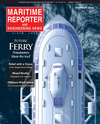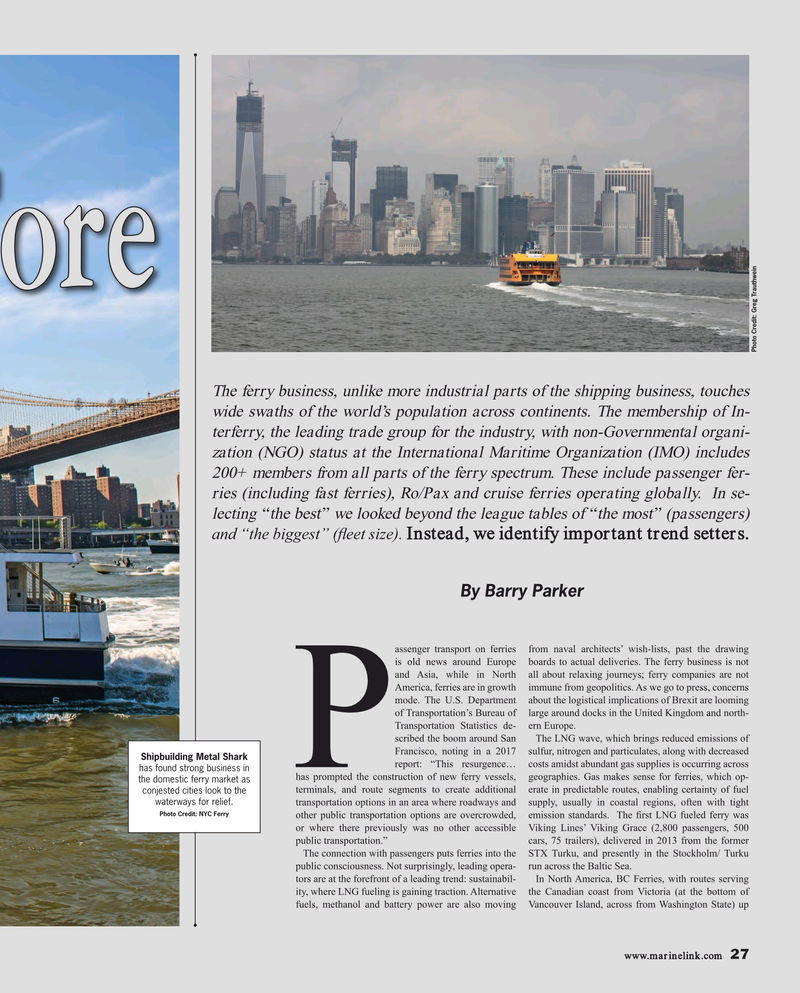
Page 27: of Maritime Reporter Magazine (February 2019)
Ferry Builders
Read this page in Pdf, Flash or Html5 edition of February 2019 Maritime Reporter Magazine
Ferries to the Fore
Photo Credit: Greg Trauthwein
The ferry business, unlike more industrial parts of the shipping business, touches wide swaths of the world’s population across continents. The membership of In- terferry, the leading trade group for the industry, with non-Governmental organi- zation (NGO) status at the International Maritime Organization (IMO) includes 200+ members from all parts of the ferry spectrum. These include passenger fer- ries (including fast ferries), Ro/Pax and cruise ferries operating globally. In se- lecting “the best” we looked beyond the league tables of “the most” (passengers)
Instead, we identify important trend setters. and “the biggest” (feet size).
By Barry Parker assenger transport on ferries from naval architects’ wish-lists, past the drawing is old news around Europe boards to actual deliveries. The ferry business is not and Asia, while in North all about relaxing journeys; ferry companies are not
America, ferries are in growth immune from geopolitics. As we go to press, concerns mode. The U.S. Department about the logistical implications of Brexit are looming of Transportation’s Bureau of large around docks in the United Kingdom and north-
Transportation Statistics de- ern Europe. scribed the boom around San The LNG wave, which brings reduced emissions of
Francisco, noting in a 2017 sulfur, nitrogen and particulates, along with decreased
Shipbuilding Metal Shark
P report: “This resurgence… costs amidst abundant gas supplies is occurring across has found strong business in has prompted the construction of new ferry vessels, geographies. Gas makes sense for ferries, which op- the domestic ferry market as terminals, and route segments to create additional erate in predictable routes, enabling certainty of fuel conjested cities look to the waterways for relief. transportation options in an area where roadways and supply, usually in coastal regions, often with tight
Photo Credit: NYC Ferry other public transportation options are overcrowded, emission standards. The frst LNG fueled ferry was or where there previously was no other accessible Viking Lines’ Viking Grace (2,800 passengers, 500 public transportation.” cars, 75 trailers), delivered in 2013 from the former
The connection with passengers puts ferries into the STX Turku, and presently in the Stockholm/ Turku public consciousness. Not surprisingly, leading opera- run across the Baltic Sea. tors are at the forefront of a leading trend: sustainabil- In North America, BC Ferries, with routes serving ity, where LNG fueling is gaining traction. Alternative the Canadian coast from Victoria (at the bottom of fuels, methanol and battery power are also moving Vancouver Island, across from Washington State) up www.marinelink.com 27

 26
26

 28
28
